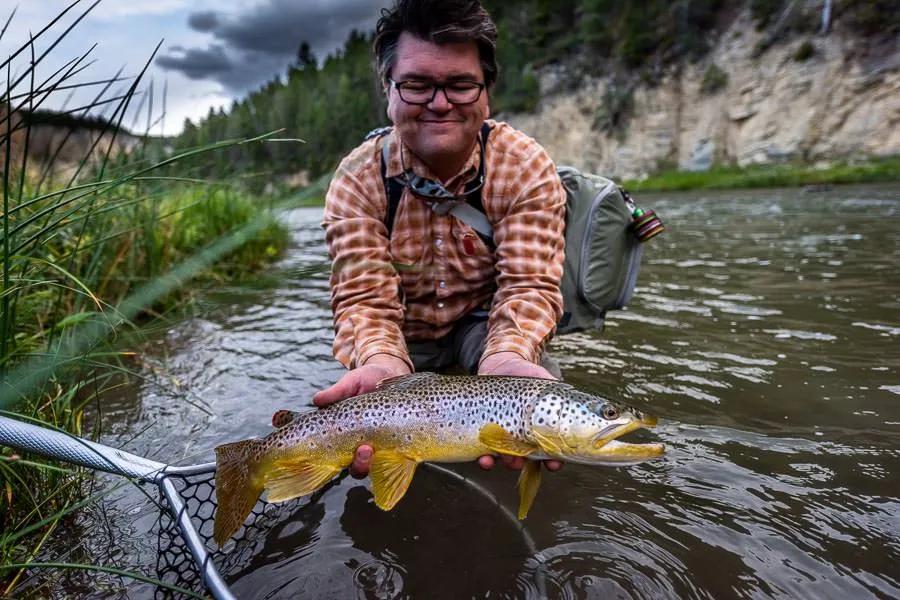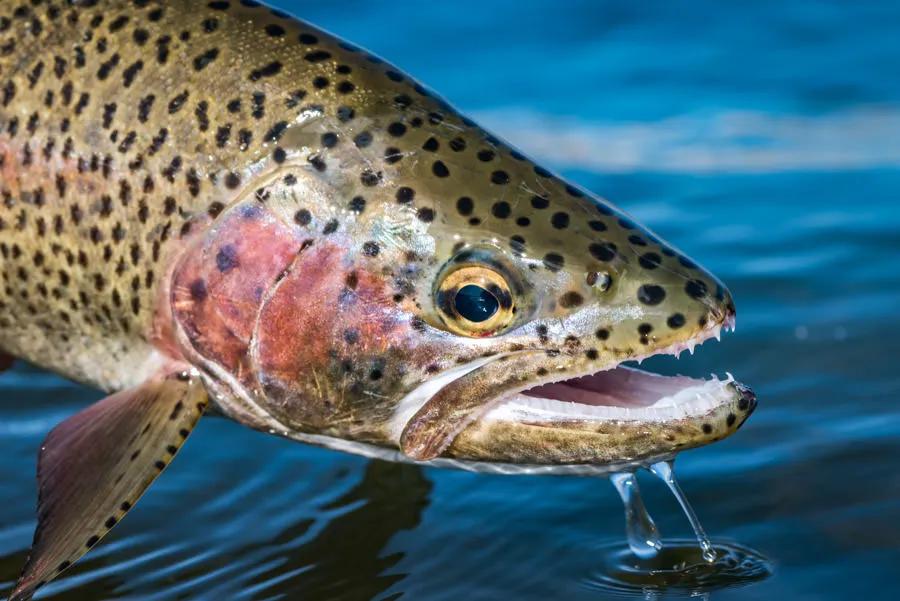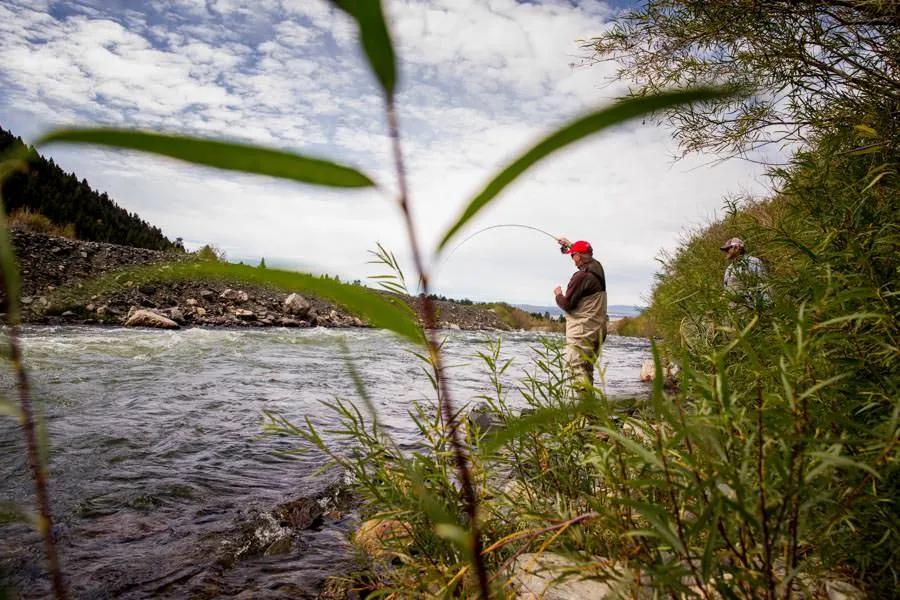
Tips for Getting the Best Drift to Catch More Fish
A crucially important technique for catching trout on a Montana fly fishing river, is getting the best possible drift. And, many times the best way to get the best drift to catch more trout is a "dead drift." The goal of the dead drift is to float flies on the surface of the water or lower in the water column, at the same speed as the current. If your flies are drifting faster or slower than the current, they won’t look natural to a fish, and are less likely to entice a trout into feeding on the flies when fly fishing in Montana.
Think of it like this: You want the flies to float in the current as if there is nothing connected to them. The challenge of course is that they are attached to your line.
When fishing dry flies, accomplishing a dead drift can be easy compared to fishing subsurface nymphs. The best way to approach a dry fly dead drift is to make a cast upstream and slightly across to the target. The most important aspect of an effective dead drift with a dry fly is to not cast the leader or fly line over the target fish. We call this "lining" or "to line the fish." If the target fish sees the fly line or leader, they will likely spook. As the fly begins to drift downstream, toward you, strip the fly line in so that there is not too much extra fly line on the surface of the water. We call this slack line. Too much slack line makes it very difficult to set the hook. Of course a cast across the current can produce a good dry fly dead drift too, it will just require mending the line to keep the fly drifting without movement.
When fishing with nymphs, a good dead drift is a crucial piece of the puzzle. It is also more challenging since the current speed on the surface of the water is typically faster that the current the nymphs are drifting in. To accomplish the best dead drift with nymphs, one or more mends of the fly line will likely be necessary.
For the purpose of this article, let’s focus on dead drifting with nymphs.
Dead drifting is primarily used when fishing for trout, but it is also effective while fishing for steelhead or smallmouth bass in rivers. Basically, anytime there is current, a dead drift is needed to make your flies look like something the fish wants to eat. In most situations, trout will be facing upstream into the current. This is gives them the advantage of letting the food come to them. Your goal is to get the flies to sink to the feeding column in which the trout are actively feeding in, then drift the flies close to the fish, enticing the fish to eat. Sometimes this is near the bottom of the river, other times it is mid column or just below the surface of the water. Wherever the fish is holding, the basic nymphing technique is the same.

Setting up a Nymph Rig
There are a few general rules when setting up a nymph rig. First, you will mostly like want to use a strike indicator. This is just another name for a bobber. While these aren’t the red and white bobbers we grew up using to drown worms, they serve the same function. The flies will be too far beneath the surface of the water to see when a fish eats the fly, so the strike indicator tells the angler when to set the hook. At all times when using a strike indicator, set the hook at the slightest amount of movement. An indicator moves for one of two reasons: either a fish has eaten one of the nymphs, or the flies have hit bottom. In both cases, the quicker you are to set the hook, the more likely you will be to catch the fish or free the flies from the bottom of the river.
Another important guideline is for the leader to be 2-3 times the water depth you are fishing. For example, if you are wanting your flies to sink 4-5 feet, the distance between your flies and indicator should be 8-9 feet. Using an indicator that can easily be adjusted is important for success.
The basic nymph rig looks like this: First, use a 7-9 foot tapered leader. A 4X or 3X leader is the most common strength. Attach the leader to the fly line, then attach the indicator about 6-10 inches for the fly line. Some of the more popular indicators are Air-Locks, Thing-a-ma-Bobber, Oros, CorQ's, and a variety of others. These indicators are popular because they float high, are easy to adjust, and are sensitive to subtle trout strikes.
Next, clip about 12-16 inches off the tapered end of the leader and re-attach this piece of line to the leader with a blood knot or triple surgeon’s knot. Crimp a piece of split shot to the leader above the knot. The knot keeps the split shot from sliding down the flies while fishing. The first fly can now be tied to the fine end of the leader. In general, this fly should be the bigger of the two flies, if you are using a two fly set up. Once attached, add a piece of tippet (3-5X) to the bend of the hook on the lead fly. The improved clinch knot is the best choice. Lastly, tie on the second (smaller) fly. The distance between the flies can vary, with a good starting distance being 10-14 inches. There should be about 7.5-8 feet of leader between the indicator and your lead fly. Now you’re ready to catch a few fish while improving your technique.

Fishing Technique
When starting, act like a predator and stealthily enter the river or quietly fish from the bank. Begin a little upstream of your target. Picture an imaginary line from your position, perpendicular to the current. This is the "center" of the dead drift. Think of the portion of the dead drift upstream of the center line as the "set up zone" and everything downstream of the line as the "catching" zone. In the setup zone, you can move the flies and make mends to create the best dead drift and sink the flies. Do not move the flies in the catching zone. Even the slightest amount of movement can tip off a trout that the fly isn’t a live insect. Cast the flies and indicator upstream, and across into the current. Keep the rod tip up and slowly lift the slack fly line off the water. As the indicator floats toward the center line, mend the line upstream of the indicator, creating a little slack in the fly line on the surface of the water. Be sure to mend before the indicator gets to the center line. This will create the perfect drag free dead drift.
Rotate your body and follow the indicator with your rod. If the indicator makes any movement, set the hook. As the current pulls the line and indicator downstream, the fly line will tighten. The dead drift is over and the swing begins. Always let the line go tight at the end of the dead drift. This will accomplish two things. First, it will cause the flies to rise in the water column making them appear to be "hatching," and potentially enticing a strike. If a fish strikes during the swing, do not set the hook. Since there is no slack in the fly line, setting the hook will result in either a poorly hooked fish that can’t easily throw the hook, or worse, a broken line as you pulled hard one way and the fish takes the fly in another.
The second reason to let the flies swing at the end of each drift is to prepare for the next cast upstream, which allows you to make a tension cast. To make an effective tension cast, the flies and split shot need to be near the surface of the water. If they are still deep in the water column, casting this long and cumbersome rig is very difficult.
When fishing with dry flies, you should be working your way upstream. When fishing with nymphs, wading downstream is the most effective. Nymph fishing is considered a searching technique. While you may have an idea of where the fish will be, it is difficult to pinpoint the exact spot they eat the fly. A great way to search a riffle or run is to make a series of dead drifts from the same location. Keep your feet still so you don’t shuffle and make noise and let the fish know you are there. Once you make your casts, each cast should create a slightly different drift. Imagine a grid on the water’s surface. Make the few casts close to your position. Each cast after that should be a little further upstream and across. The goal is to drift the flies in parallel lines 10-12 inches apart. Once you’ve covered the water, move downstream about the length of one fly rod and start the grid over. This way you are sure to not miss any potential feeding fish.

Key Tips for Getting a Dead Drift
Most of the time to get the best dead drift, an upstream mend is needed. Occasionally, a downstream mend will create a better dead drift. An easy way to make a quick assessment is by reading the current. If the current is moving at the same speed as the water you are standing in, then an upstream mend will likely be the best choice. If you are wading in current slower than where the flies are drifting, then a downstream drift will be best. Experimenting will yield the ideal results. Study the indicator closely, if you see any ripples or wake on the water around the indicator, then the flies are not dead drifting effectively. If the flies are not dead drifting, trout are less inclined to eat them.
Line control is key to an effective dead drift. It is crucial to have enough fly line on the water so that the flies and indicator drift in the current drag free, which is a true dead drift. The challenge lies with having just the right amount of slack line on the water. Too much can create great dead drifts, but it also makes the hook set nearly impossible. Too little slack fly line on the water causes the flies to move faster or slower through the water column unnaturally and without attention from fish. The trick is to achieve the perfect balance of slack line for an ideal dead drift and hook setting power.

Never Miss a Hook Set Again
Finally, when setting the hook there is one important tip that will produce strong hook ups and more fish to the net. When nymphing subsurface always, always, always set the hook downstream, and toward the bank. Because trout are facing into the current, the most effective hook set is one made towards the downstream bank. Think of it like this: with the fish is facing upstream, if the hook set is made up river, the fly is likely to be pulled away from the fish. If the fish does happen to get stuck with the hook, most likely the fly won’t penetrate deep enough to keep the fish on the line.
Setting the hook with a quick movement of the rod toward the down stream bank, the fly is more likely to be pulled deep into the corner of fish’s mouth, and is less likely for the fish to be able to spit the fly out, even with a barbless hook. So if you are fishing on river right with the current moving from left to right, then set the hook to the right. When fishing river left, set to the left. If you have ever experienced long line release after long line release, there is good chance the hook was being set upstream and the hook was only getting a small piece of the fish’s lips.
Mastering a dead drift is a key component of improving your catch rate on rivers like the Madison or Missouri. Because trout are going to be more likely to strike a fly that looks natural as it floats-on or drifts-in the current, it is crucial that you make the flies look as natural as possible. In most instances and during most hatches the best way for flies to look natural is with a dead drift. Fortunately, the only way to improve your dead drift technique is to go fishing.
